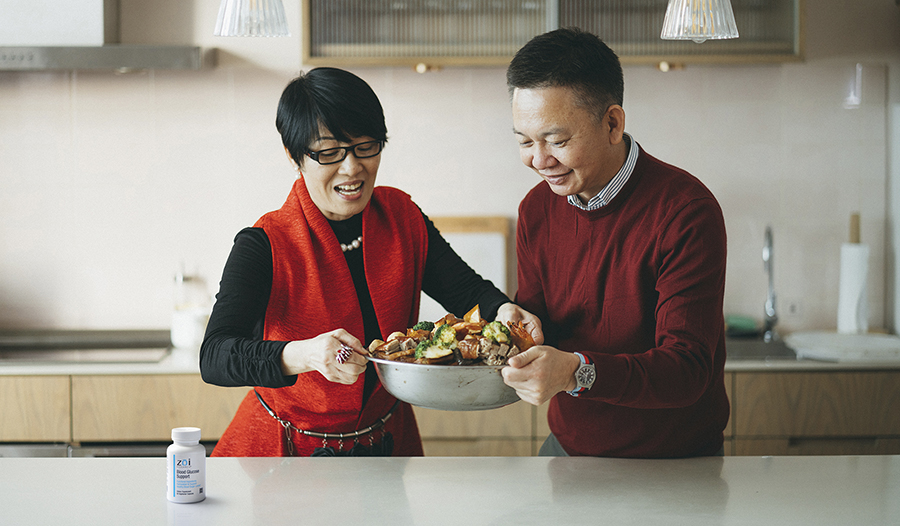Pasti sani per le feste che non fanno male alla glicemia

Le vacanze si avvicinano e probabilmente vi state chiedendo quali cose sane e deliziose potete preparare per i vostri cari che non solo nutrano la loro anima ma anche il loro corpo! Questo aspetto è ancora più importante se voi o i vostri cari avete problemi di glicemia, perché alcuni dei tipici dolcetti delle feste possono danneggiare i livelli di zucchero nel sangue e farli sentire poco dolci.
Ecco alcuni dei miei piatti e dolcetti preferiti per le feste che riducono al minimo gli zuccheri artificiali e sfruttano la scienza dei macro, delle fibre , dell'indice glicemico e del carico glicemico per mantenere normali i livelli di insulina mentre si banchetta. , indice glicemico e carico glicemico per mantenere normali i livelli di insulina durante i pasti.
Perché la glicemia è importante
Se voi o una persona cara avete difficoltà a gestire i livelli di zucchero nel sangue, potreste essere arrivati a pensare che mangiare qualsiasi tipo di zucchero sia dannoso, compresi gli zuccheri della frutta e gli amidi della verdura, ma questo non è vero! Non tutti gli zuccheri fanno male. Per comprendere questo concetto, rivediamo alcune basi della biologia umana e della scienza della nutrizione. Dopo di che, passiamo alle ricette!
Le cellule funzionano con lo zucchero
Ogni cellula del corpo funziona con il glucosio. Quando le cellule vengono private del glucosio, non sono in grado di creare l'energia necessaria per le oltre 500 reazioni biochimiche che avvengono ogni giorno nel corpo. Ne conseguono sintomi di ipoglicemia e di scarsa energia, tra cui affaticamento, nebbia cerebrale o pensiero rallentato e confuso, debolezza, tremori e persino sintomi emotivi come tristezza e irritabilità. Non è divertente, per non dire altro!
Dagli esempi precedenti si evince che lo zucchero è importante per la nostra sopravvivenza e il nostro benessere, ma di cosa stiamo parlando quando parliamo della necessità di gestire la glicemia? I nostri ormoni come l'insulina, la leptina, la grelina e altri ancora.
Ormoni e abitudini contribuiscono ai problemi di zucchero nel sangue
In caso di resistenza all'insulina o di produzione inadeguata di insulina, come accade rispettivamente nel diabete di tipo 2 e nel diabete di tipo 1, le cellule non ricevono abbastanza zuccheri, anche se si mangia la giusta quantità di zucchero ogni giorno. Questo perché l'insulina è la chiave biochimica che sblocca le nostre cellule e permette loro di assorbire lo zucchero che mangiamo. Senza insulina, le cellule non possono accettare il glucosio dal sangue e ci sentiamo ipoglicemici anche dopo aver mangiato a sufficienza. Quindi, il problema non è tanto lo zucchero quanto l'insulina.
L'insulina è un ormone e la sua produzione e funzione possono essere alterate nel tempo da alcune malattie e abitudini di vita. Il diabete di tipo 2 può spesso essere risolto con una combinazione di farmaci, stile di vita e dieta. Il diabete di tipo 1 non può essere invertito e richiede una gestione farmaceutica con insulina. Nel resto dell'articolo parleremo di abitudini alimentari e di stile di vita che possono aiutare chi produce una quantità normale o eccessiva di insulina.
Se si soffre di un qualsiasi tipo di diabete, prima di apportare cambiamenti drastici alla propria dieta è bene rivolgersi al proprio medico di base, all'endocrinologo o ad altri specialisti. Se state cercando di invertire ciò che il vostro medico vi ha detto essere "glicemia alta", le ricette e le idee che seguono vi aiuteranno a farlo.
L'indice glicemico e il carico glicemico sono più importanti
Sapevate che esiste un codice segreto che vi permetterà di mangiare ancora zuccheri e amidi senza influenzare drasticamente la glicemia? Si chiama indice glicemico o carico glicemico. L'indice glicemico confronta il modo in cui un alimento influisce sulla glicemia rispetto al glucosio. Più alto è l'indice glicemico, più un alimento è zuccherino e più è probabile che faccia impennare rapidamente la glicemia.
Gli alimenti ad alto indice glicemico includono pane bianco, riso bianco e zucchero di canna. Gli alimenti a basso indice glicemico includono molte verdure verdi, noci, e semi.
I pasti e gli spuntini che seguono includono per lo più alimenti a basso contenuto glicemico, che vi aiuteranno a mantenervi in salute pur avendo la sensazione di aver mangiato a sazietà!
I pasti delle feste che non fanno male alla glicemia
Contorni sani: Verdure arrostite
Molte persone amano il sapore di mais arrostito, cavolini di Bruxelles, asparagi, broccoli, carote e altro ancora, ma dimenticano di preparare questi contorni per concentrarsi sulla portata principale. La maggior parte delle verdure ha un indice glicemico/carico glicemico incredibilmente basso perché sono povere di zuccheri, ricche di fibre e con un contenuto moderato di amido. Ancora più importante, sono ricchi di sostanze nutritive, come vitamine e minerali, di cui abbiamo bisogno per mantenere in salute il sistema immunitario, il sistema cardiovascolare e la pelle.
Sebbene il burro non sia ricco di zuccheri, è un alimento ad alto contenuto di calorie, grassi saturi e, in genere, di sale. Cercate di arrostire con meno olio o burro possibile e prendete in considerazione strumenti come un tappetino da forno in silicone per evitarne completamente l'uso.
Prova le seguenti combinazioni per creare lati che scompaiono come per magia dopo averli spenti:
- Cavoletti di Bruxelles e fette di pancetta
- Carote arrostite con timo e/o finocchio
- Patate arrosto ricoperte di condimento italiano (di solito origano, timo, e basilico)
- Mais arrostito con peperoni rossi piccanti
- Asparagi arrostiti con aglio e limone
Antipasti, crudité e taglieri di salumi
Molti scelgono di servire antipasti, crudité e salumi prima della portata principale. In questo modo si possono consumare spuntini abbastanza salutari mentre si aspetta che il cibo venga cucinato e si può socializzare con lo stomaco non vuoto, il che rende sempre la conversazione migliore! Molti degli alimenti serviti nei taglieri di salumi sono già a basso contenuto glicemico, tra cui:
- Verdure fresche
- Olive
- Affettati
- Noci
- Peperoni arrostiti e verdure conservate come cipolle o aglio
- Salsine a base di fagioli e lenticchie
Consiglio di incentrare la tavola su questi elementi e di includere anche la frutta fresca (non quella secca), lasciando fuori i latticini, i cracker, i formaggi e le creme spalmabili, che possono aumentare l'apporto calorico e far impennare la glicemia. Forse vi sorprenderà sapere che i latticini possono aumentare la glicemia, ma alcune ricerche dimostrano che i latticini di mucca possono far impennare i livelli di insulina più dello zucchero di canna, il che gli conferisce un indice glicemico più elevato. Per questo motivo, le persone che hanno difficoltà a gestire la glicemia evitano o limitano i latticini.
Carne e verdure
Tacchino e asparagi, manzo e fagiolini, pollo e broccoli arrostiti... sono tutte ottime idee di ricette per chi mangia carne e vuole tenere sotto controllo la glicemia durante le feste. La carne è sempre a basso contenuto glicemico, a meno che non si aggiungano impanature, condimenti o salse che contengono carboidrati o zuccheri. Per questo motivo, consiglio di grigliare la carne o di arrostirla in padella con le verdure per mantenere basso il contenuto di zucchero.
Fagioli e lenticchie
I piatti a base di fagioli e lenticchie sono a basso contenuto glicemico nonostante la presenza di carboidrati, perché sono ricchi di fibre. Provate un polpettone di lenticchie al posto di quello di carne, o un'insalata di fagioli bianchi e spinaci con una pasta di ceci come piatto principale per aumentare il contenuto di fibre e allo stesso tempo godervi un piatto gustoso.
Dolci sani
Purè di patate dolci alla cannella: Questa ricetta facile da preparare contiene solo 5 grammi di zucchero e 14 carboidrati netti per porzione. Per prepararlo, è sufficiente arrostire 4-5 piccole patate dolci intere nel forno dopo averle pulite. Fate diversi buchi per far uscire l'aria durante la cottura e lasciate la buccia per ottenere più fibre e nutrienti. Di solito cuocio le mie a 450 gradi per circa 45 minuti. Una volta arrostite, tiratele fuori dal forno e schiacciatele. Potete anche mescolarli in un robot da cucina, se è più facile. Una volta schiacciate, aggiungere alle patate dolci spezie come la cannella o il mix di spezie per la torta di zucca, fino a raggiungere il gusto desiderato. Se non è abbastanza dolce per i vostri gusti, potete aggiungere un dolcificante non calorico come la stevia a piacere. Il purè può essere servito caldo o freddo. È uno dei piatti preferiti dalle feste e serve circa 8-10 persone.
Budino di semi di cocco: I budini ai semi di chia sono una scelta obbligata quando si tratta di preparare dessert gustosi che aggiungono più nutrienti che zuccheri alla giornata. Tutti partono fondamentalmente dallo stesso principio: qualche cucchiaio di semi di chia, una o due tazze di latte non lattiero-caseario, un po' di stevia e un po' di frutta. Si possono aromatizzare con vaniglia, cacao in polvere, cannellae altro ancora, per trasformare la base relativamente insapore in un gusto a piacere. Potete anche aggiungere un po' di menta piperita a un budino di semi di chia aromatizzato al cacao per ottenere un gustoso trattamento simile al gelato con gocce di cioccolato alla menta, ma senza zucchero.
ESONERO DI RESPONSABILITÀ:Questo Centro Benessere non intende fornire diagnosi...

















































































 Indice
Indice


